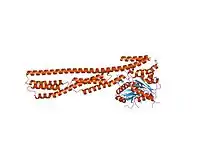Guanylate-binding protein
In molecular biology, the guanylate-binding proteins family is a family of GTPases that is induced by interferon (IFN)-gamma. GTPases induced by IFN-gamma (Interferon-inducible GTPase) are key to the protective immunity against microbial and viral pathogens. These GTPases are classified into three groups: the small 47-KD immunity-related GTPases (IRGs), the Mx proteins (MX1, MX2), and the large 65- to 67-kd GTPases. Guanylate-binding proteins (GBP) fall into the last class.[1]
| Guanylate-binding protein, N-terminal domain | |||||||||
|---|---|---|---|---|---|---|---|---|---|
 structure of human guanylate binding protein-1 in nucleotide free form | |||||||||
| Identifiers | |||||||||
| Symbol | GBP | ||||||||
| Pfam | PF02263 | ||||||||
| Pfam clan | CL0023 | ||||||||
| InterPro | IPR015894 | ||||||||
| SCOP2 | 1dg3 / SCOPe / SUPFAM | ||||||||
| |||||||||
| Guanylate-binding protein, C-terminal domain | |||||||||
|---|---|---|---|---|---|---|---|---|---|
 Structure of human guanylate binding protein-1 in nucleotide free form | |||||||||
| Identifiers | |||||||||
| Symbol | GBP_C | ||||||||
| Pfam | PF02841 | ||||||||
| InterPro | IPR003191 | ||||||||
| SCOP2 | 1dg3 / SCOPe / SUPFAM | ||||||||
| |||||||||
GBP genes have been universally recognized in mammalian as well as in most other vertebrate genomes.[2] A single cluster of seven human GBP genes (GBP1-GBP7) is found on chromosome 1q22.2. Unlike humans, in genetically controllable disease models such as mice and zebrafish,[3] members of the GBPs gene family are organized in more than one cluster, in this case, 11 (Gbp2b- Gbp110 and 4 genes (Gbp1-Gbp4), respectively. Examinations of GBP-related sequences have shown that zebrafish gbp3 and gbp4 contain an additional function to find (FIIND) and a caspase recruitment (CARD) domains that resemble those found within the inflammasome-related proteins: Apoptosis-associated speck-like protein containing a CARD (PYCARD) and NLR Family Pyrin Domain Containing 1 (NLRP1).[3][4]
Structurally, GBPs consist of two domains: a globular N- terminal domain harboring the GTPase function, and an extended C- terminal helical domain.[3][5] In addition, some members of the GBPs family harbor motifs (e.g., CaaX motifs) or additional domains that are thought to operate in protein-protein or protein-membrane interactions.[6][7]
Some GBPs have exhibited the ability to bind not only guanosine triphosphate (GTP) to produce guanosine diphosphate (GDP) but also GDP to produce guanosine monophosphate (GMP) with equimolar affinity and high intrinsic rates of hydrolyzation. The physiological relevance of the GBP's GDPase activity might yield important insights to elucidate GBP-specific defensive profile versus other INF-induced GTPases(e.g.IRGs).[7] Evidence has suggested GBPs as important players in a variety of disease conditions ranging from infectious and metabolic inflammatory diseases to cancer,[3][8] In the context of cell protection against bacteria, early efforts conducting loss-function assays revealed a reduced host resistance to several pathogens when lacking GBPs.[9] More recent studies have indicated that GBPs appear to be an agent that disturbs the structural integrity of bacteria, stimulates inflammasome signaling, forms complexes on pathogen-containing vesicles in infected cells, and fosters autophagy and oxidative mechanisms helping pathogen clearance.[10][11]
Human GBP1 is secreted from cells without the need of a leader peptide, and has been shown to exhibit antiviral activity against Vesicular stomatitis virus and Encephalomyocarditis virus, as well as being able to regulate the inhibition of proliferation and invasion of endothelial cells in response to IFN-gamma.[12]
References
- Tripal P, Bauer M, Naschberger E, Mortinger T, Hohenadl C, Cornali E, Thurau M, Sturzl M (January 2007). "Unique features of different members of the human guanylate-binding protein family". J. Interferon Cytokine Res. 27 (1): 44–52. doi:10.1089/jir.2007.0086. PMID 17266443.
- Kutsch M, Coers J (January 2021). "Human guanylate binding proteins: nanomachines orchestrating host defense". FEBS J. 288 (20): 5826–5849. doi:10.1111/febs.15662. PMC 8196077. PMID 33314740.
- Kim BH, Chee JD, Bradfield CJ, Park ES, Kumar P, MacMicking JD (May 2016). "Interferon-induced guanylate-binding proteins in inflammasome activation and host defense". Nat. Immunol. 17 (5): 481–9. doi:10.1038/ni.3440. PMC 4961213. PMID 27092805.
- >Forn-Cuní G, Meijer AH, Varela M (Aug 2019). "Zebrafish in Inflammasome Research". Cells. 8 (8): 901. doi:10.3390/cells8080901. PMC 6721725. PMID 31443239.
- >Santos JC, Broz P (Oct 2018). "Sensing of invading pathogens by GBPs: At the crossroads between cell‐autonomous and innate immunity". J Leukoc Biol. 104 (4): 729–735. doi:10.1002/JLB.4MR0118-038R. PMID 30020539. S2CID 51680456.
- >Britzen-Laurent N, Bauer M, Berton V, Fischer N, Syguda A, Reipschläger S, Naschberger E, Herrmann C, Stürzl M (Dec 2010). "Intracellular Trafficking of Guanylate-Binding Proteins Is Regulated by Heterodimerization in a Hierarchical Manner". PLOS ONE. 5 (12): e14246. Bibcode:2010PLoSO...514246B. doi:10.1371/journal.pone.0014246. PMC 2998424. PMID 21151871.
- >Tretina K, Park ES, Maminska A, MacMicking JD (Mar 2019). "Interferon-induced guanylate-binding proteins: Guardians of host defense in health and disease". J Exp Med. 216 (3): 482–500. doi:10.1084/jem.20182031. PMC 6400534. PMID 30755454.
- >Honkala AT, Tailor D, Malhotra SV (Jan 2020). "An Emerging Target in Inflammation and Cancer". Front. Immunol. 10 (5): 31–39. doi:10.3389/fimmu.2019.03139. PMC 4961213. PMID 27092805.
- >TShenoy AR, Wellington DA, Kumar P, Kassa H, Booth CJ, Cresswell P, MacMicking JD (March 2019). "GBP5 promotes NLRP3 inflammasome assembly and immunity in mammals". Science. 336 (6080): 481–5. doi:10.1126/science.1217141. PMID 22461501. S2CID 206539020.
- >Wandel MP, Kim BH, Park ES, Boyle KB, Nayak K, Lagrange B, Herod A, Henry T, Zilbauer M, Rohde J, MacMicking JD, Randow F (August 2020). "Guanylate-binding proteins convert cytosolic bacteria into caspase-4 signaling platforms". Nat. Immunol. 21 (8): 880–891. doi:10.1038/s41590-020-0697-2. PMC 7381384. PMID 32541830.
- >Meunier E, Wallet P, Dreier RF, Costanzo S, Anton L, Rühl S, Dussurgey S, Dick MS, Kistner A, Rigard M, Degrandi D, Pfeffer K, Yamamoto M, Henry T, Broz P (May 2015). "Guanylate-binding proteins promote activation of the AIM2 inflammasome during infection with Francisella novicida". Nat. Immunol. 16 (5): 476–484. doi:10.1038/ni.3119. PMC 4568307. PMID 25774716.
- Naschberger E, Lubeseder-Martellato C, Meyer N, Gessner R, Kremmer E, Gessner A, Sturzl M (September 2006). "Human guanylate binding protein-1 is a secreted GTPase present in increased concentrations in the cerebrospinal fluid of patients with bacterial meningitis". Am. J. Pathol. 169 (3): 1088–99. doi:10.2353/ajpath.2006.060244. PMC 1698817. PMID 16936281.